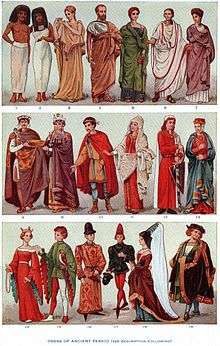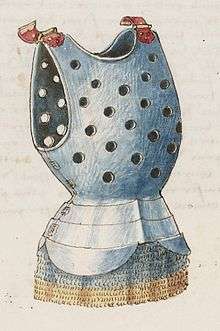Codpiece
A codpiece (from Middle English: cod, meaning "scrotum") is a covering flap or pouch that attaches to the front of the crotch of men's trousers, enclosing the genital area. It may be held closed by string ties, buttons, folds, or other methods. It was an important fashion item of European clothing during the fifteenth and sixteenth centuries. In the modern era, clothing devices with similar functions as codpieces are worn in some styles of underwear, in the leather subculture, and in performance costumes, such as for rock music and metal musicians. A similar device with rigid construction, an athletic cup, is used as protective underwear for male athletes.
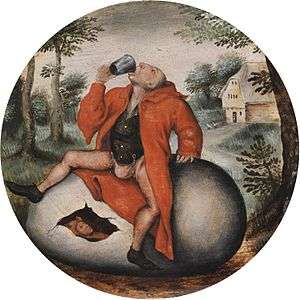
In European fashion
From the ancient world there are extant depictions of articles of clothing designed to cover just the male genitalia; for example, archaeological recovery at Minoan Knossos on Crete has yielded figurines, some of whom wear only a garment covering the male genitalia.[1] However, the codpiece, per se, appeared in everyday European fashion for men only many centuries later, associated with hose and trousers.
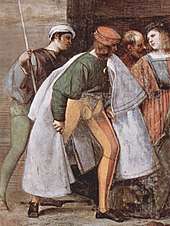
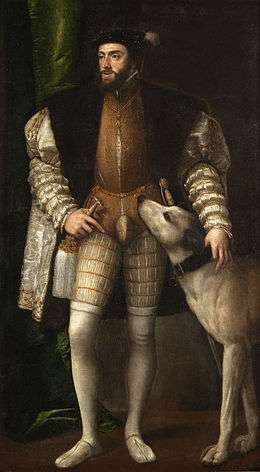
In fourteenth century European fashions, men's hose were two separate legs worn over linen drawers, leaving a man's genitals covered only by a layer of the linen drawers. As the century wore on and men's hemline fashion rose, the hose became longer and joined at the centre back, there rising to the waist, but remaining open at the centre front. Further shortening of the cote or doublet fashion resulted in more prominence of the genitals, so the codpiece began life as a triangular piece of fabric covering the gap to disguise that. Most of what is known about the cut, fit, and materials used for Renaissance codpieces is through portraits, clothing inventories, receipts for payments and tailor cutting guides.[3]


As time passed, codpieces became shaped and padded to emphasize rather than to conceal, mostly the penis. It even became fashionable to design the codpiece to hold the penis in a position that insinuated that it was erect constantly.
Such excessive codpieces became an object of derision showered on outlandish fashions. The Renaissance author, François Rabelais, refers satirically to a book entitled On the Dignity of Codpieces, in the foreword to his 1532 book, The Histories of Gargantua and Pantagruel.[5]
This fashion reached its peak of size and decoration in the 1540s before falling out of use by the 1590s.
Suits of armor of the sixteenth century followed civilian fashion, and for a time, codpieces were a prominent addition to the best full suits.
A few examples of full suits of armor with codpieces are on display in museums today. The Metropolitan Museum of Art in New York City has one. The Higgins Armory[6] in Worcester, Massachusetts also had an example on display until its close. The armor of Henry VIII displayed in the Tower of London has a codpiece as well.[7]
Examples of metal parts of such armor, seen here, are depicted by Wendelin Boeheim in his 1890 publication on the history of weapons, Handbuch der Waffenkunde, which was published in Leipzig, Germany.[8]
Derivatives in contemporary costumes
Subcultural attire
A jock strap is another protective article of clothing that resembles a codpiece. Imitations of them made of leather may be worn in leather subcultural attire to cover and confine the genitals of a man, sometimes while wearing leather chaps. Rather than accentuating the male genitalia through exaggeration of the size of the wearer's penis and testicles, attention may be drawn to the genital area through decorative adornment such as metallic studs in such articles of clothing.
Heavy metal fashion
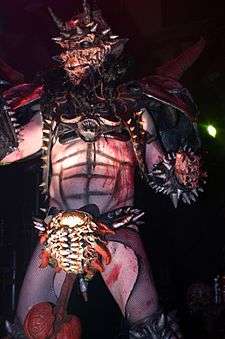
This type of clothing crossed over from the leather subculture to become an established part of heavy metal fashion performance costume when Rob Halford, of the band Judas Priest, began wearing clothing adopted from the gay biker and leather subculture while promoting the Killing Machine album (also called Hell Bent for Leather) in 1978.[9] Heavy metal singer King Diamond has been known to wear a similar article of clothing as part of his performance outfits. Black metal musician and Satanist Infernus wore this type of clothing as part of his attire during the Ad Majorem Sathanas Gloriam era of Gorgoroth. GWAR frontman Oderus Urungus also wore something he called The Cuttlefish of Cthulhu,[10] that resembles the crossover article.
Pop music costumes
The Cameo front man Larry Blackmon sports such a crossover article of clothing that became his trademark in his videos "Word Up" and "Candy". Guns N' Roses front man Axl Rose wore one for most of the Appetite for Destruction Tour. Jethro Tull front man Ian Anderson performed in a similar article of clothing during the mid-1970s.
High fashion forays
Derivatives occasionally make an appearance on the haute couture catwalk. Jean Paul Gaultier,[11] Thom Brown (2008,[12] 2012,[13] 2014[14]) and Versace (2014[15]) are designers who have used similar designs to explore themes of masculinity and sexuality.
See also
- Koteka
- Kynodesme
- Willy warmer
- 1500–1550 in fashion
- 1550–1600 in fashion
References
Notes
- Hogan, C. Michael (22 December 2007). "Knossos Fieldnotes". The Modern Antiquatarian. Archived from the original on 9 April 2016. Retrieved 14 October 2018.
- The Yorck Project (2002) 10.000 Meisterwerke der Malerei (DVD-ROM), distributed by DIRECTMEDIA Publishing GmbH. ISBN 3936122202.
- Vicary, Grace Q. (February 1989). "Visual Art as Social Data: The Renaissance Codpiece". Cultural Anthropology. 4 (1): 3–25. doi:10.1525/can.1989.4.1.02a00010. ISSN 0886-7356.
- Boeheim, Wendelin, Handbuch der Waffenkunde. Das Waffenwesen in seiner historischen Entwickelung vom Beginn des Mittelalters bis zum Ende des 18. Jahrhunderts (= Seemanns kunstgewerbliche Handbücher. Bd. 7, ZDB-ID 53757-3). Seemann, Leipzig 1890.
- "Worlds of the Renaissance 2000 - Dina McArdle Project". Albertrabil.com. Archived from the original on 2004-01-21. Retrieved 2012-01-19.
- John Grabenstein, "Archived copy". Archived from the original on 2016-10-12. Retrieved 2005-09-17.CS1 maint: archived copy as title (link).
- Paddock, David Edge & John Miles (1995). Arms & armor of the medieval knight : an illustrated history of weaponry in the Middle Ages (Reprinted. ed.). New York: Crescent Books. ISBN 978-0517103197.
- Boeheim, Wendelin, Handbuch der Waffenkunde. Das Waffenwesen in seiner historischen Entwickelung vom Beginn des Mittelalters bis zum Ende des 18. Jahrhunderts (= Seemanns kunstgewerbliche Handbücher. Bd. 7, ZDB-ID 53757-3). Seemann, Leipzig 1890.
- Weider, Judy (12 May 1998). "Judas Priest's Rob Halford is first heavy metal band member to say he is gay". The Advocate. Archived from the original on 11 April 2008. Retrieved 14 October 2018.
- Childers, Chad (17 April 2017). "11 Most Epic Codpieces in Rock + Metal". Loudwire. Retrieved 8 November 2018.
- D'Souza, Karen (26 March 2012). "A tribute to the bad boy of fashion: Jean Paul Gaultier". The Mercury News. Retrieved 15 October 2018.
- Waldron, Glen (25 February 2008). "Thom Browne: The long and the short of it". The Independent. Retrieved 15 October 2018.
- Standen, Dirk (19 June 2011). "Moncler Gamme Bleu Spring 2012 Menswear Fashion Show". Vogue. Retrieved 15 October 2018.
- "Thom Browne Spring 2014 Menswear Fashion Show". Vogue. 2014. Retrieved 15 October 2018.
- Blanks, Tim (11 January 2014). "Versace Fall 2014 Menswear Fashion Show". Vogue. Retrieved 15 October 2018.
Further reading
- Ashelford, Jane: The Art of Dress: Clothing and Society 1500–1914, Abrams, 1996. ISBN 0-8109-6317-5.
- Ashelford, Jane. The Visual History of Costume: The Sixteenth Century. 1983 edition (ISBN 0-89676-076-6), 1994 reprint (ISBN 0-7134-6828-9).
- Edge, David: Arms and Armor of Medieval Knights: An Illustrated History of Weaponry in the Middle Ages.
- Hearn, Karen, ed. Dynasties: Painting in Tudor and Jacobean England 1530–1630. New York: Rizzoli, 1995. ISBN 0-8478-1940-X.
- Bodemer, Brett: "Pantagruel's Seventh Chapter:The Title as Suspect Codpiece."
External links

- Codpieces in art from The Guardian
- New York Times interview with a codpiece maker
_MET_DT773.jpg)
